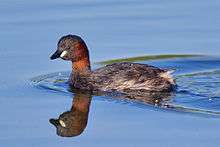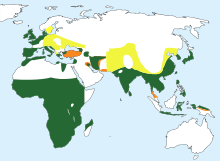Little grebe
| Little grebe | |
|---|---|
 | |
| In breeding plumage | |
 | |
| Non-breeding plumage | |
| Scientific classification | |
| Kingdom: | Animalia |
| Phylum: | Chordata |
| Class: | Aves |
| Order: | Podicipediformes |
| Family: | Podicipedidae |
| Genus: | Tachybaptus |
| Species: | T. ruficollis |
| Binomial name | |
| Tachybaptus ruficollis (Pallas, 1764) | |
 | |
| Range of T. ruficollis Breeding range Year-round range Wintering range | |
| Synonyms | |
|
Podiceps ruficollis | |
The little grebe (Tachybaptus ruficollis), also known as dabchick, is a member of the grebe family of water birds. The genus name is from Ancient Greek takhus "fast" and bapto "to sink under". The specific ruficollis is from Latin rufus "red" and Modern Latin -collis, "-necked", itself derived from Latin collum "neck".[2]
At 23 to 29 cm (9.1 to 11.4 in) in length it is the smallest European member of its family. It is commonly found in open bodies of water across most of its range.
Taxonomy
The little grebe was described by the German naturalist Peter Simon Pallas in 1764 and given the binomial name Colymbus ruficollis.[3][4][5] There are nine currently-recognized subspecies, separated principally by size and colouration.[6][7]
- T. r. ruficollis – (Pallas, 1764): nominate, found from Europe and western Russia south to North Africa[8]
- T. r. iraquensis – (Ticehurst, 1923): found in southeastern Iraq and southwestern Iran[8]
- T. r. capensis – (Salvadori, 1884): found in Sub-Saharan Africa, Madagascar, Sri Lanka, and the Indian subcontinent, extending east to Burma[8]
- T. r. poggei – (Reichenow, 1902): found from southeastern to northeastern Asia, Hainan, Taiwan, Japan, and south Kuril Islands[8]
- T. r. philippensis – (Bonnaterre, 1790): found in the northern Philippines[8]
- T. r. cotabato – (Rand, 1948): found on Mindanao[8]
The following three subspecies are sometimes split as the tricolored grebe (Tachybaptus tricolor):[7]
- T. r. tricolor – (Gray, GR, 1861): found from Sulawesi to New Guinea and the Lesser Sundas[8]
- T. r. vulcanorum – (Rensch, 1929): found from Java to Timor[8]
- T. r. collaris – (Mayr, 1945): found from northeastern New Guinea to Bougainville[8]
Description
The little grebe is a small water bird with a pointed bill. The adult is unmistakable in summer, predominantly dark above with its rich, rufous colour neck, cheeks and flanks, and bright yellow gape. The rufous is replaced by a dirty brownish grey in non-breeding and juvenile birds.
Juvenile birds have a yellow bill with a small black tip, and black and white streaks on the cheeks and sides of the neck as seen below. This yellow bill darkens as the juveniles age, eventually turning black in adulthood.
In winter, its size, buff plumage, with a darker back and cap, and “powder puff” rear end enable easy identification of this species. The little grebe's breeding call, given singly or in duet, is a trilled repeated weet-weet-weet or wee-wee-wee which sounds like a horse whinnying.
Distribution
This bird breeds in small colonies in heavily vegetated areas of freshwater lakes across Europe, much of Asia down to New Guinea, and most of Africa. Most birds move to more open or coastal waters in winter, but it is only migratory in those parts of its range where the waters freeze. Outside of breeding season, it moves into more open water, occasionally even appearing on the coast in small bays.[1]
Behaviour
The little grebe is an excellent swimmer and diver and pursues its fish and aquatic invertebrate prey underwater. It uses the vegetation skilfully as a hiding place.
Like all grebes, it nests at the water's edge, since its legs are set very far back and it cannot walk well. Usually four to seven eggs are laid. When the adult bird leaves the nest it usually takes care to cover the eggs with weeds. This makes it less likely to be detected by predators.[9] The young leave the nest and can swim soon after hatching, and chicks are often carried on the backs of the swimming adults.[10] In India, the species breeds during the rainy season.[11]
It does not normally interbreed with the larger grebes in the Old World, but a bird in Cornwall mated with a vagrant North American pied-billed grebe, producing hybrid young.

 Little Grebe nest at edge of lake in Jodhpur, Rajasthan, India
Little Grebe nest at edge of lake in Jodhpur, Rajasthan, India- Eggs, Collection Museum Wiesbaden
References
- 1 2 BirdLife International (2012). "Tachybaptus ruficollis". IUCN Red List of Threatened Species. Version 2013.2. International Union for Conservation of Nature. Retrieved 26 November 2013.
- ↑ Jobling, James A (2010). The Helm Dictionary of Scientific Bird Names. London: Christopher Helm. pp. 341, 377. ISBN 978-1-4081-2501-4.
- ↑ Mayr, Ernst; Cottrell, G. William (1979). Check-list of Birds of the World. Volume (1 Second ed.). Cambridge, Massachusetts: Museum of Comparative Zoology. p. 143.
- ↑ Sherborn, C. Davies (1905). "The new species of birds in Vroeg's catalogue, 1764". Smithsonian Miscellaneous Collections. 47: 332–341 [339 No. 281]. Includes a transcript of the 1764 text.
- ↑ Rookmaaker, L.C.; Pieters, F.F.J.M. (2000). "Birds in the sales catalogue of Adriaan Vroeg (1764) described by Pallas and Vosmaer". Contributions to Zoology. 69 (4): 271–277.
- ↑ Ogilvie, Malcolm; Rose, Chris (2003). Grebes of the World. Bruce Coleman. ISBN 1-872842-03-8.
- 1 2 Gill, F.; Donsker, D., eds. (2014). "IOC World Bird List (v 4.4)". doi:10.14344/IOC.ML.4.4.
- 1 2 3 4 5 6 7 8 9 Clements, James (2007). The Clements Checklist of the Birds of the World (6th ed.). Ithaca, NY: Cornell University Press. ISBN 978-0-8014-4501-9.
- ↑ Prokop, Pavel; Trnka, Alfréd (2011). "Why do grebes cover their nests? Laboratory and field tests of two alternative hypotheses" (PDF). Journal of Ethology. 29: 17–22. doi:10.1007/s10164-010-0214-4.
- ↑ Finn, Frank (1905). "Notes on the nesting of the Indian Dabchick". Bird Notes. 4: 10–17.
- ↑ Dalgliesh, Gordon (1906). "Notes on the Indian Podicipedidae". The Avicultural Magazine. 5 (2): 65–72.
External links
| Wikimedia Commons has media related to Tachybaptus ruficollis. |
| Wikispecies has information related to: Tachybaptus ruficollis |
- Ageing and sexing (PDF) by Javier Blasco-Zumeta & Gerd-Michael Heinze
- BTO BirdFacts - Little Grebe
- Grebes of the World by André Konter
- Information and Illustration on Little Grebe from A Field Guide to Birds of Armenia
- BirdLife species factsheet for Tachybaptus ruficollis
- "Tachybaptus ruficollis". Avibase.

- "Little grebe media". Internet Bird Collection.
- Little grebe photo gallery at VIREO (Drexel University)
- Audio recordings of Little grebe on Xeno-canto.

.jpg)